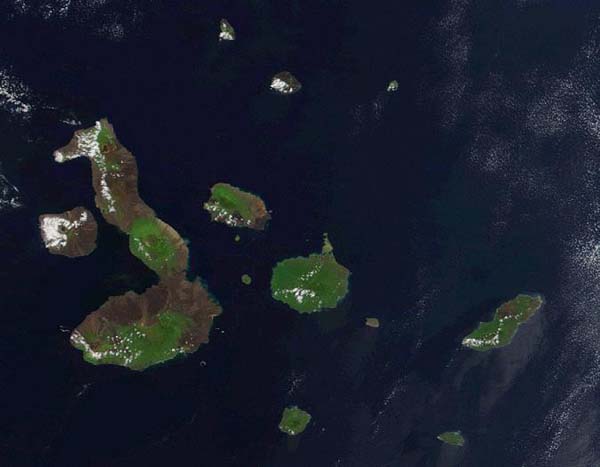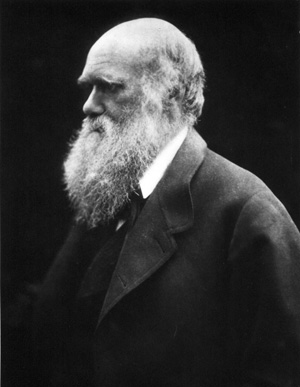 |
usa | world | animals | vocabulary | health | science | math | history |
The Galapagos Islands
The Galápagos Islands are an archipelago of some 13 volcanic islands and associated islets and rocks located in the Pacific Ocean about 1,000 kilometers west of the coast of South America. The Galápagos archipelago is politically part of Ecuador. The oldest of the islands are about 4 million years old and the youngest are still in the process of being formed. Indeed, the Galápagos islands are considered to be one of the most active volcanic areas in the world. They are famed for their vast number of endemic species and the studies conducted by Charles Darwin that led to his theory of natural selection.

The Galapagos Islands(NASA satellite photo)
The Galápagos were discovered by chance in March 10, 1535 when Dominican Fray Tomás de Berlanga, the Bishop of Panama, sailed to Peru to settle a dispute between Francisco Pizarro and his lieutenants after the conquest of the Incas, while performing an administrative mission for the Spanish Monarch Carlos V. The bishop's ship stalled when the winds died and strong currents carried him out to the Galápagos. In his account of the adventure, addressed to Emperor Carlos V, Berlanga described the harsh, desert-like condition of the islands and their trademark giant tortoises. He wrote about the marine iguanas, the sea lions and the many types of birds. He also noted the remarkable tameness of the animals that continues to thrill and delight modern visitors.
The islands are believed to date back to six million years ago as a result of volcanic activity generated beneath the ocean's floor. They were uninhabited, although Thor Heyerdahl in 1963 reported findings of pottery of South American origin that suggested earlier contacts, a theory that appears to still be controversial. The archipelago was used as hiding place by the English pirates that pilfered the Spanish galleons carrying gold and silver from South America to Spain.
The islands first appeared on maps in about 1570 in those drawn by Abraham Ortelius and Mercator. The islands were called "Insulae de los Galopegos" (Islands of the Tortoises).
Alexander Selkirk, the man whose adventures in Juan Fernández Islands inspired Daniel Defoe to write Robinson Crusoe, visited the Galápagos in 1708 after he was picked up from Juan Fernández by the privateer Woodes Rogers. Rogers was refitting his ships in the islands after sacking Guayaquil.
In 1793, James Collnet made a description of the flora and fauna of Galápagos and suggested that the islands could be used as base for the whalers operating in the Pacific Ocean. He also draw the first accurate navigation charts of the islands. Whalers killed and captured thousands of the Galápagos tortoises to extract their fat. The tortoises could also be kept on board ship as a means of providing of fresh protein as these animals could survive for several months on board without any food or water. The hunting of the tortoises was responsible for greatly diminishing and in some cases eliminating certain races. Along with whalers came the fur-seal hunters who brought the population of this animal close to extinction.
Ecuador annexed the Galápagos Islands on February 12, 1832, naming it Archipelago of Ecuador. This was a new name that added to several names that had been, and are still, used to refer to the archipelago. The first governor of Galápagos, General José de Villamil, brought a group of convicts to populate the island of Floreana and in October 1832 some artisans and farmers joined.
The Voyage of the Beagle brought the survey ship HMS Beagle under captain Robert FitzRoy to the Galápagos on September 15, 1835 to survey approaches to harbors. The captain and others on board including his companion the young naturalist Charles Darwin made a scientific study of geology and biology on four of the thirteen islands before they left on October 20 to continue on their round-the-world expedition. The governor of the prison colony on Charles Island told Darwin that tortoises differed from island to island, and when specimens of birds were analysed on return to England it was found that many different kinds of birds were species of finches which were also unique to islands. These facts were crucial in Darwin's development of his evolution theory, which was presented in The Origin of Species.

Charles Darwin
Though the first protective legislation for the Galápagos was enacted in 1934 and supplemented in 1936, it was not until the late 1950s that positive action was taken to control on what was happening to the native flora and fauna. In 1955, the International Union for the Conservation of Nature organised a fact-finding mission to the Galápagos. Two years later, in 1957, UNESCO in cooperation with the Government of Ecuador sent another expedition to study the conservation situation and to choose a site for a research station.
In 1959, the centenary year of Darwin's publication of The Origin of Species, the Ecuadorean government declared 97.5% of the archipelago's land area, except áreas already colonised, as a national park. In the same year, the Charles Darwin Foundation was founded, with its international headquarters in Brussels. Its primary objectives were to ensure the conservation of unique Galápagos ecosystems and promote the scientific studies necessary to fulfil its conservation functions. With the establishment of the Charles Darwin Research Station in 1964, conservation work began. During the early years, conservation programs, such as eradication of introduced species and protection of native species, were carried out by Station personnel. Currently, most of the scientific work carried out in the Galápagos by resident scientists is directed toward conservation goals; the work of most visiting scientists is oriented towards pure research.
When the national park was established, approximately 1,000 to 2,000 people called the islands their home. In 1972 a census was done in the archipelago and a population of 3,488 was recorded. By the 1980s, this number had dramatically risen to more than 15,000 people.
In 1986 the surrounding ocean was declared a marine reserve. UNESCO recognised the islands as a World Heritage Site in 1978, which was extended in December 2001 to include the marine reserve.
This article is licensed under the GNU Free Documentation License. It uses material from the Wikipedia article "Galápagos".